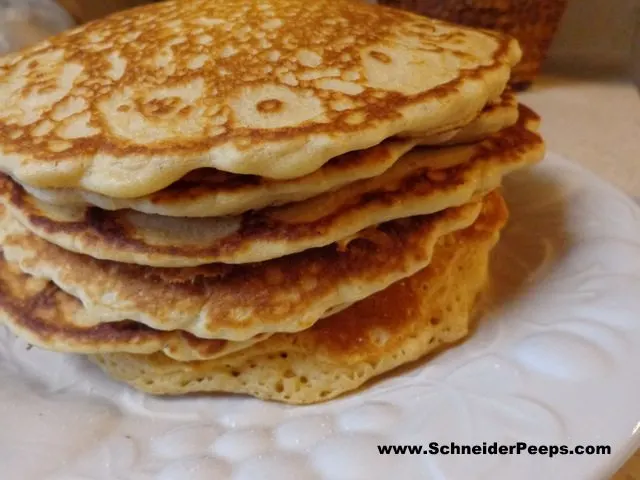Yesterday, we spent some time baking. I’m trying to get some snack type foods in the freezer before we start our school year in a few weeks. During the year, we have more outside of the house commitments and it’s nice to be able to just grab some muffins to take with us since some days we are gone for 3-4 hours at a time. Also, Christian will have a class at the college that starts at 9am three mornings a week. So he probably won’t be eating breakfast with us most mornings and, lets face it, cold cereal just isn’t very filling.
I’ve had several questions lately about baking with freshly ground flour so I thought I’d share a few tips I’ve learned over the years. I’ve mentioned before that Kara from Home With Purpose has a great series on grains. She also recommends Grains of Truth, Using Whole Grains the Easy Way as a resource for the history of grains and other information. So if you’re wondering about the history of different grains, definitely go check out her series.
First, let me say that the whole wheat found in the bag in the store is not the same as freshly ground whole wheat. When you use store bought whole wheat you will probably only be able to replace about half the white flour in your recipes. It is courser than freshly ground. Before the grain is ground, or milled, it is completely shelf stable for a very long time – like years and years and years. But once the hull is cracked it begins to lose nutrients and can go rancid. There’s all kinds of “information” floating around the internet about how quickly it goes rancid and how many nutrients are lost. All I need to know is that it happens and that’s enough for me. However, if it’s a choice between using all white flour or store bought wheat flour with some white flour, I’d choose the latter.
 {Grain Mill} In order to grind grain in to flour, you need a grain mill. There are hand operated ones and electric ones. There is no one perfect mill, each one has advantages and disadvantages. I bought the KTEC Kitchen Mill – Grain and Flour Mill (K-Tec) about 10 years ago and have only had to send it in one time to get a popcorn kernel out. I probably use the mill on average 4 days a week. At the time, there was only this and the WhisperMill on the market and the WhisperMill was about $100 more expensive. I had a friend who had the WhisperMill and using hers I decided that it wasn’t $100 quieter than the KTEC. The WhisperMill company went under and WonderMill bought it or reorganized it or something. I’m not sure when NutriMill came on the market. I have several friends who have them and love them. I don’t think they are really much quieter than the KTEC but I do love the little “drawer” that the flour drops down into. If you don’t have much space, the KTEC is the most compact. The KTEC is manufactured in the USA and the NutriMill is manufactured in S. Korea if that is important to you.
{Grain Mill} In order to grind grain in to flour, you need a grain mill. There are hand operated ones and electric ones. There is no one perfect mill, each one has advantages and disadvantages. I bought the KTEC Kitchen Mill – Grain and Flour Mill (K-Tec) about 10 years ago and have only had to send it in one time to get a popcorn kernel out. I probably use the mill on average 4 days a week. At the time, there was only this and the WhisperMill on the market and the WhisperMill was about $100 more expensive. I had a friend who had the WhisperMill and using hers I decided that it wasn’t $100 quieter than the KTEC. The WhisperMill company went under and WonderMill bought it or reorganized it or something. I’m not sure when NutriMill came on the market. I have several friends who have them and love them. I don’t think they are really much quieter than the KTEC but I do love the little “drawer” that the flour drops down into. If you don’t have much space, the KTEC is the most compact. The KTEC is manufactured in the USA and the NutriMill is manufactured in S. Korea if that is important to you.
 {Grains} There are a lot different grains available. We mainly use hard white or red wheat, soft white wheat, popcorn and flax.
{Grains} There are a lot different grains available. We mainly use hard white or red wheat, soft white wheat, popcorn and flax.
Hard white or red wheat is what is used anytime we use a recipe that has yeast in it. The hard wheat has more gluten in it and that is what helps the bread react with the yeast and rise. We use this for our pizza crusts and our regular bread which we use to make loaves, rolls and hamburger buns. We prefer the white to the red as it has a milder flavor, but before I found Honeyville Foods I sometimes could not get the white and so we’ve gotten used to using red, too.
Soft white wheat, or pastry wheat, is used anytime there is not yeast in the recipe. So we use this for pancakes, waffles, quick breads, biscuits, scones, etc.
Popcorn is ground when we want to make cornbread. I’m not sure if all mills will grind popcorn so double check your user guide before doing this.
Flax cannot be ground in the grain mill because it is too oily. We have a coffee grinder that is used only for the flax. I don’t usually measure the flax, I just pour it in the mill, grind it up and then dump it into the recipe with the other dry ingredients. I’ve added it to lots of recipes without having to adjust any other measurements.
 {Measuring} One cup of wheat berries (that is what that the whole wheat is called) will give you about one and half cups of flour. For some recipes I don’t even measure the flour, just the berries. For instance, I know that I need 7.5 cups of flour for our waffles. So I grind 5 cups of berries and then just dump the flour into the bowl. For other recipes, like our pizza crusts, I measure the flour. I usually have extra and I keep a bag in the freezer to put any extra flour in. I don’t keep them separate, I just keep adding to the bag. At some point I will want to make something like cinnamon toast cake and need just a few cups of flour and so this is the flour I will use. I just don’t use for things with yeast.
{Measuring} One cup of wheat berries (that is what that the whole wheat is called) will give you about one and half cups of flour. For some recipes I don’t even measure the flour, just the berries. For instance, I know that I need 7.5 cups of flour for our waffles. So I grind 5 cups of berries and then just dump the flour into the bowl. For other recipes, like our pizza crusts, I measure the flour. I usually have extra and I keep a bag in the freezer to put any extra flour in. I don’t keep them separate, I just keep adding to the bag. At some point I will want to make something like cinnamon toast cake and need just a few cups of flour and so this is the flour I will use. I just don’t use for things with yeast. {Cost} How cost effective is it to grind your own flour and cook from scratch? I have no idea. And honestly for us it doesn’t really matter. We feel better when we don’t eat alot of white flour and processed foods.
After the initial cost of the mill (which for me has averaged $15 a year and that average will decrease with each year I have my mill) the only other non normal expense would be the grain. Wheat is about $1 a pound when you order from Honeyville Foods and they charge $4.49 to ship your order right to your door. White flour in our local store is about $2 for a 5lb bag, so the wheat berries are definitely more than buying white flour. Whole wheat flour is anywhere from $4-$5 for a 5lb bag, so milling your own is very comparable in cost to whole wheat flour in the grocery store.
If you have any questions or tips feel free to leave them in comments.

Rachel E.
Tuesday 9th of August 2011
Thanks for sharing, Angi. I am encouraged to get a mill and grind my own flour. I will have to do research around here to find out if berries are accessible before buying a mill. I think if you are getting a superior product and it is healthier, it makes more sense.